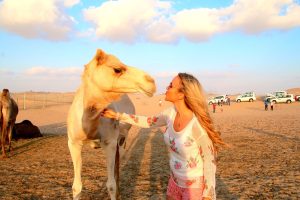
Riding High in the Desert: Camel Trekking Adventures in Abu Dhabi
Are you looking for a soothing adventure in the heart of Abu Dhabi? Camel trekking is the ideal spot, offering the perfect blend of calmness and excitement. Picture yourself sitting atop a majestic camel and rhyming with its movement. Step away from the bustling city life and immerse yourself in the calmness. The crispy desert air narrates the story of ancient lives, and the heat waves carry the warmth. The golden dunes of the desert create a masterpiece that fascinates us. This is a lifetime experience every person should enjoy. We are unwrapping the beauty of the Abu Dhabi deserts, here is all you need to know before heading camel trekking. Let us explore the majestic desert adventure that awaits you in the Arabian treasure. Which is the best Season to visit? The winter season, from November to March, is the greatest time to explore Abu Dhabi and the majestic deserts. The weather is warmer and less humid than it is in the summer. The temperature swings from 18 to 25 degrees during the day, making it ideal for outdoor activities without worrying about the impact of the heat. It is not recommended to travel during August since it is the warmest month, with a dry environment and high summer waves. If you have a limited budget, you may travel in April and May or from September to October. Spring and fall bring great weather, moderate crowds, and affordable hotel costs. Is it fun riding camels? Yes, it is possible. After all, what better way to experience the scorching, shimmering desert than from above, silently moving in formation across dunes? Many adults and nearly all children like the experience. Sure, you’ll be bobbing up and down a little, and you could get aching legs, so check for the ride duration and the resting spots. As long as you are active and cheerful, you will have a great time. It’s important to remember that you will be part of a group headed by experienced Bedouins who have a strong connection with the animals and understand how best to care for them. We’re in good hands because they were raised in the desert and have extensive knowledge of the area. What to wear During the camel ride? Wearing loose-fitted, comfortable clothes is essential while riding a camel. The weather is scorching, so choose clothes that protect you from the sun. Clothes Choose airy, lightweight clothing covering your arms and legs to protect yourself from the sun and any bush or thorns you may encounter. Clothing that fits loosely is excellent since it makes mobility easier. Avoid wearing heavy fabrics and short dresses. Do not prefer fitted clothes, as they may cause itching and burning due to sweat. You can do well with cotton or other natural fibres. And remember always to wear a hat. Footwear You are advised to wear boots and closed-toe shoes. I prefer wearing thick frim stoles, and it is also recommended to wear ankle boots. This will provide ultimate protection from the sun, Layering If you visit during winter, you should layer your clothes. Abu Dhabi has extreme climates; it can be freezing at night and sunny during the day. So wear layers that can be removed during the day. TIP: Bring sunscreen protection and a water bottle. Sunscreen protects your skin from sunlight and reduces skin damage from UV exposure. Carry water bottles to stay hydrated. What is the real experience of a camel trekking? As previously stated, while it is undoubtedly enjoyable, the fact is that it is not always fully pleasant or easy! Before you begin, here are a few things to keep in mind: Camels grunt, gurgle, puff, and groan and yell. This is how they communicate with one another. They may even grind their teeth on occasion! Don’t be afraid it’s all part of the adventure! Camels travel slowly, so expect to limp at a moderate and steady pace rather than sprinting over the desert. Camels are more stubborn and strong. So you need to fight with your hands and rope to guide them. But if it seems they are out of your control or you are uncomfortable with their behaviour, Bedouins always step in to help you. Tips for camel trekking If you touch your horse before a ride or offer them some straw, they will probably reach out and smell your hand. Unfortunately, this is not the case with camels; you risk getting bitten or kicked if you attempt to pet one. To ride and disembark your camel, first ensure that it is kneeling. If necessary, seek assistance from a Bedouin guide to keep the animal still. Swing your right leg across while placing your left foot on the stirrup. Securely hold onto your saddle with both hands as soon as you’re aboard. When your camel stands up, lean back; at that point, you can proceed. Keep your body weight centred and evenly distributed; if not, it affects your and the camel’s balance. Sit relaxed and keep your back straight. Do not lean forward or backward frequently. Managing your camel: Here’s where you use the reins. The rein will regulate the camel’s direction on the right side of its head. The rein you’ll use to control speed is on the left side. Pull on both reins simultaneously to move your camel ahead and halt it; pull only on the left rein. And tug tightly on one rope while loosening the other to get your camel to spin around. Things to Know Before the Camel Trekking Book in Advance Book the camel trekking in advance. If you are visiting during the tourist season or looking for a ride on a specific day to celebrate special occasions in the desert, it is necessary to book prior. Prior booking allows you to choose your slot according to your preference and also allows you to change your preferences. 2. Health condition Pregnant women are not allowed to ride the camels







